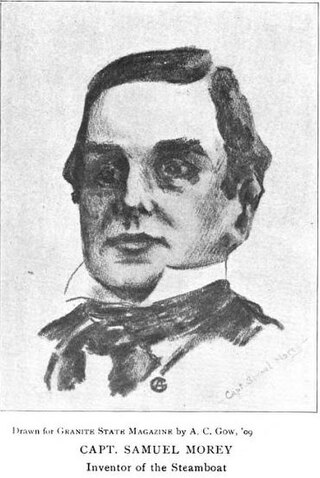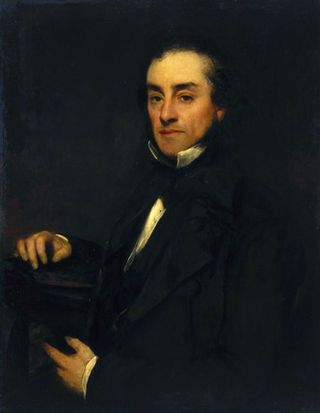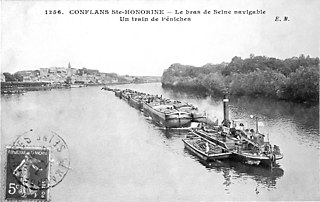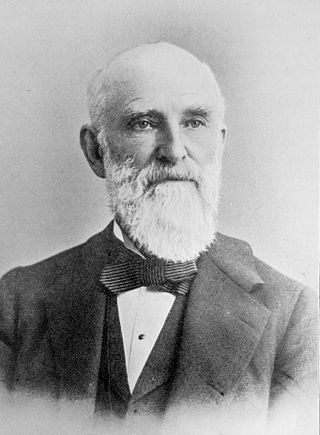
A propeller is a device with a rotating hub and radiating blades that are set at a pitch to form a helical spiral which, when rotated, exerts linear thrust upon a working fluid such as water or air. Propellers are used to pump fluid through a pipe or duct, or to create thrust to propel a boat through water or an aircraft through air. The blades are shaped so that their rotational motion through the fluid causes a pressure difference between the two surfaces of the blade by Bernoulli's principle which exerts force on the fluid. Most marine propellers are screw propellers with helical blades rotating on a propeller shaft with an approximately horizontal axis.

A vehicle is a piece of equipment designed to transport people, cargo or both. Vehicles include wagons, bicycles, motor vehicles, railed vehicles, watercraft, amphibious vehicles, aircraft and spacecraft.

A steamship, often referred to as a steamer, is a type of steam-powered vessel, typically ocean-faring and seaworthy, that is propelled by one or more steam engines that typically move (turn) propellers or paddlewheels. The first steamships came into practical usage during the early 1800s; however, there were exceptions that came before. Steamships usually use the prefix designations of "PS" for paddle steamer or "SS" for screw steamer. As paddle steamers became less common, "SS" is assumed by many to stand for "steamship". Ships powered by internal combustion engines use a prefix such as "MV" for motor vessel, so it is not correct to use "SS" for most modern vessels.

A steamboat is a boat that is propelled primarily by steam power, typically driving propellers or paddlewheels. Steamboats sometimes use the prefix designation SS, S.S. or S/S or PS ; however, these designations are most often used for steamships.

Samuel Morey was an American inventor, who worked on early internal combustion engines and was a pioneer in steamships who accumulated a total of 20 patents.

A paddle steamer is a steamship or steamboat powered by a steam engine that drives paddle wheels to propel the craft through the water. In antiquity, paddle wheelers followed the development of poles, oars and sails, where the first uses were wheelers driven by animals or humans.

Steam frigates and the smaller steam corvettes, steam sloops, steam gunboats and steam schooners, were steam-powered warships that were not meant to stand in the line of battle. There were some exceptions like for example the French Napoléon class steam ship of the line was meant to stand in the line of battle, making it the world's first steam battleship. The first such ships were paddle steamers. Later on the invention of screw propulsion enabled construction of steam-powered versions of the traditional ships of the line, frigates, corvettes, sloops and gunboats.

The Lake Champlain Transportation Company is a vehicle ferry operator that runs three routes across Lake Champlain between the US states of New York and Vermont. From 1976 to 2003, the company was owned by Burlington, Vermont, businessman Raymond C. Pecor Jr., who is chairman of its board. In 2003, he sold the company to his son, Raymond Pecor III.

Marine propulsion is the mechanism or system used to generate thrust to move a watercraft through water. While paddles and sails are still used on some smaller boats, most modern ships are propelled by mechanical systems consisting of an electric motor or internal combustion engine driving a propeller, or less frequently, in pump-jets, an impeller. Marine engineering is the discipline concerned with the engineering design process of marine propulsion systems.

Sir Francis Pettit Smith was an English inventor and, along with John Ericsson, one of the inventors of the screw propeller. He was also the driving force behind the construction of the world's first screw-propelled steamship, SS Archimedes.

SS Archimedes was a steamship built in Britain in 1839. She was the world's first steamship to be driven successfully by a screw propeller.

Chain-boat navigation or chain-ship navigation is a little-known chapter in the history of shipping on European rivers. From around the middle of the 19th century, vessels called chain boats were used to haul strings of barges upstream by using a fixed chain lying on the bed of a river. The chain was raised from the riverbed to pass over the deck of the steamer, being hauled by a heavy winch powered by a steam engine. A variety of companies operated chain boat services on rivers such as the Elbe, Rhine, Neckar, Main, Saale, Havel, Spree and Saône as well as other rivers in Belgium and the Netherlands. Chain boats were also used in the United States.

A paddle wheel is a form of waterwheel or impeller in which a number of paddles are set around the periphery of the wheel. It has several uses, of which some are:

A screw steamer or screw steamship is an old term for a steamship or steamboat powered by a steam engine, using one or more propellers to propel it through the water. Such a ship was also known as an "iron screw steam ship".

Burra Bra was a Manly ferry on Sydney Harbour that operated by the Port Jackson & Manly Steamship Company from 1908 until 1940, before being requisitioned by the Royal Australian Navy for use as an anti-submarine training vessel and target tow during World War II.
Robert Wilson FRSE FRSSA was a Scottish engineer, remembered as inventor of a special kind of a screw propeller, which he demonstrated in 1827. Wilson also designed a self-acting motion for steam hammers which was key to making them practical for industrial use, among many other inventions.

A team boat, horse boat, or horse ferry, is a watercraft powered by horses or mules, generally using a treadmill, which serves as a horse engine. Team boats were popular as ferries in the United States from the mid-1810s to the 1850s.

Steam-powered vessels include steamboats and steamships. Smaller steamboats were developed first. They were replaced by larger steamships which were often ocean-going. Steamships required a change in propulsion technology from sail to paddlewheel to screw to steam turbines. The latter innovation changed the design of vessels to one that could move faster through the water. Engine propulsion changed to steam turbine in the early 20th century. In the latter part of the 20th century, these, in turn, were replaced by gas turbines.

Henry Augustus Stearns brought steam laundry to California, was a cotton wadding mill owner in Rhode Island, and a Lieutenant Governor of Rhode Island.
Experiment was one of the first ferries servicing the Sydney Cove to Parramatta run, and later became Brisbane's first ferry.




















